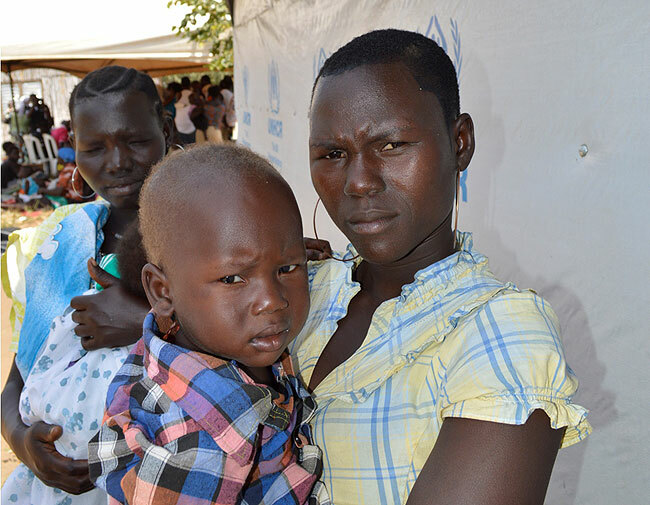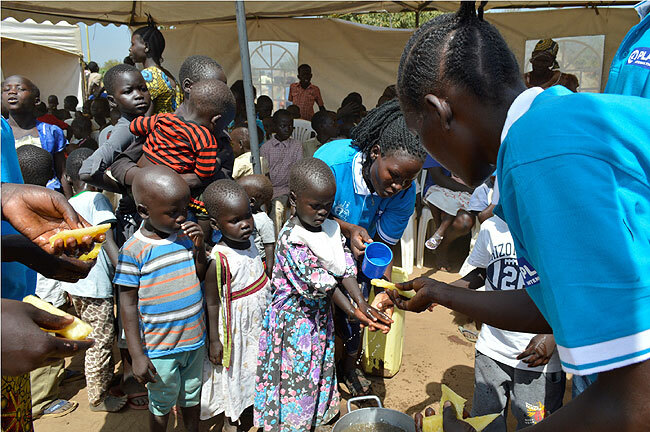Malnutrition a threat to lives in Adjumani
Apr 03, 2018
“Feeding a child on only one type of food leads to malnutrition because it will deny the body of other essential nutrients."

HEALTH | NUTRITION
Jacqueline Mandera, 25, started living with her boyfriend five years ago in Agojjo Refugee Settlement Camp in Adjumani district. She dreamed of a better future with him, having grown up in a poor family, where she did not get a chance to attend school.
Three years later, after giving birth, Mandera's boyfriend left the refugee camp to seek a job in Kampala. He would never return.
And with his departure vanished Mandera's excitement about motherhood and hope for a better future. Her baby suffered severe malnutrition and, at two-and-a-half years, the child looks like a one-year-old.
Now vending fried cassava in Agojjo, Mandera says her child has never drunk milk because she cannot afford it.
The child cannot stand, her belly is swollen, her hair brown and she is sickly - all signs pointing to malnutrition.
"I thought my baby had been bewitched," says the young mother.
Fortunately for Mandera and other parents with malnourished children in Adjumani, there is a ray of hope, thanks to the Reach Every Mother And Child with Nutrition in Emergency (REMAC-NiE) project by Plan International.
"At the camp, I was told that my baby girl was malnourished. I was advised to give her a balanced diet and the organisation gave me different foods and also taught me how to feed her," Mandera adds.
Cissy Kaamu, the national health programme manager at Plan International Uganda, says despite Uganda being referred to as a food basket owing to its fertile soils and climate favourable for agriculture, Ugandan children still suffer from malnutrition.
She says parents and guardians are ignorant about the proper manner in which to feed their children. In addition, poverty is still a challenge.
A person who does not have the right nutritional composition for their body is considered malnourished, manifested through undernutrition or overnutrition.
Fighting malnutrition
According to Kaamu, the project is being implemented in Agojjo settlement and four villages in the host communities, including Biangiba, Malera, Duba and Agojo central.
Children aged from one month to 14 years, pregnant women and breasfeeding mothers, including teenage ones, are the target.
Dr Harriet Aciro, a medical officer at Adjumani General Hospital, says Uganda's biggest challenge is undernutrition, especially in children under the age of five. The indicators in this case are underweight, stunting and wasting.
Indeed, statistics from the Uganda Demographic and Health Survey 2011 indicate that more than two million children below the age of five are stunted and about 250,000 children in this age group suffer from severe malnutrition every year and are in need of medical treatment.
"Feeding a child on only one type of food leads to malnutrition because it will deny the body of other essential nutrients. Children should be fed properly and given proper medical care for their mental and physical growth," Aciro advises.

James Odongo, the senior portfolio manager for Plan Uganda, says some parents have enough food, but prepare it poorly.
"We need to educate mothers on how best to cook the food because it loses its nutrients if it is prepared using wrong methods," he says.
He also cautions mothers against using polythene bags to steam the food as this is deadly.
Because of the high cost of banana leaves, he says, many people, especially in urban areas, steam their food with polythene bags.
Community response
Jackie Ovizia, a resident of Ciforo, welcomed the project.
"The fact that the project is going to focus on children, pregnant and breastfeeding mothers and not only to teach us about good feeding, but also to facilitate us to learn good agricultural practices to improve food security, makes it good for our community."
Beatrice Mundrua, of Agojjo settlement, says: "Plan has given us good services. This is an impression that there is need for the services to be brought near to the community.
Prevention of malnutrition
A research by REMAC-NiE project shows that malnutrition starts before birth and for children in Uganda, about 11% of children are born stunted and about 16% are likely to be wasted at birth.
The first 1,000 days of a child's life include the nine months before they are born and the first two years of development.
This, as Aciro explains, greatly impacts a child's cognitive, motor and social emotional skills, as well as physical growth and development.
Malnutrition interventions
Aciro says Uganda is well-endowed with a number of affordable and readily available nutritious foods such as fruits (mangoes, pineapples, pawpaws, tomatoes, jackfruit, oranges and vegetables (doodo, nakati, bbuga, cabbages, bitter berries (katunkuma), cauliflower, carrots and spinach) that can satisfy the nutritional demands of mothers and their babies.
The mother should get enough rest to preserve and gain energy for daily chores. Seek medical advice about body weight gain to ensure good growth of the unborn baby and a good start in life of the new-born.
Take iron and folic acid for proper growth of the baby. Sources of iron and folic acid include millet porridge, liver, lean meat, nakati and green leafy vegetables such as spinach, broccoli and cauliflower.
For the first six months, breastfeeding is the best way to meet the nutritional needs of infants as it limits exposure to infections.
Even HIV-positive mothers should breastfeed exclusively as they take their anti-retroviral drugs to prevent mother-to-child HIV transmission, on advice of their healthcare provider.
Haspha Nassolo, a senior nursing officer in Kampala, says it is important to give adequate complementary feeds to a baby after six months and continue breastfeeding (if required).
And these include nutritious foods such as Irish potatoes, pumpkin, porridge, fish or mushroom soup, fruits, vegetables and animal milk in baby's diet.
Ensure proper nutrition and care when the baby is sick and give adequate food and liquids and breast milk for a week after recovery.
According to Nassolo, an underweight child is described as one who weighs less in relation to their age whereas a stunted one is shorter in relation to their age. A wasted child weighs less in relation to their height and a result of acute food shortage.
Besides these forms of undernutrition, children can also suffer from what is known as micronutrient deficiency. This, as Aciro explains, is as a result of prolonged inadequate intake of micronutrients.
The most common micronutrients Ugandan children miss out on are vitamin A, iron, zinc and iodine.

Effects of under nutrition
The undernourished individuals usually have slow growth, micronutrient deficiencies and diminished mental capacity, among others, which affect school performance and national development.
Death can also occur in severe states of under nutrition.
Causes of malnutrition
According to a 2012 USAID report, the causes of under nutrition vary by region, but include availability and access to food, lack of dietary diversity, cultural and social traditions and poverty levels.
Sharon Naluwende, a nutritionist at Mulago Hospital, says undernutrition results from both immediate and underlying causes.
The immediate causes, she explains, include inadequate breastfeeding, lack of nutrient-rich foods and poor eating routines, poor feeding and care practices, inadequate parenting (unavailability of parents at home due to work routines and high burden of diseases.
The underlying causes include food insecurity - inadequate availability, poor economic access or own production and inadequate food utilisation, inadequate feeding and caring resources, unsafe and unhygienic environment, according to information from Uganda's demographic survey of 2014.
Economic constraints have seen some parents in areas of plenty sell off such foods such as milk, eggs or fish so that they can get money for other household needs.
For example, statistics in Bushenyi district done by demographic surveys show that despite the district being one of the leading producers of milk and other food stuffs, a number of children in the district are malnourished. This can be explained by the fact that most of the milk or matooke produced is sold.
The project
Molly Adokorach, the project co-ordinator of REMAC-NiE, says the intervention is being implemented using the positive deviance/hearth model (PD hearth).
"A PD hearth nutrition programme is a home and neighbourhood-based nutrition one for children at risk of protein-energy malnutrition in developing countries."
According to Adokorach, the programme uses the "positive deviance" approach to identify those behaviours practised by the mothers or caregivers of well-nourished children from poor families and transfer such positive practices to others in the community with malnourished children.
She adds that another component of the programme is food security through empowering farmers' groups with knowledge and skills for good agricultural practices.
Expected results
Adokorach says preventive primary healthcare and curative service are improved by ensuring increased access to health promotion awareness, nutrition assessments and treatment of some children under five
Since the REMAC project started, households have increased gardening and food production in the refugee settlements and host communities.
According to Kaamu, households have increased access to sustainable and improved water, sanitation and hygiene facilities and children living in violence free communities.
Uganda has made remarkable strides in improving the welfare of the population in the past 20 years, but some key welfare issues, especially regarding nutritional status, are still wanting.
